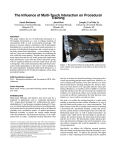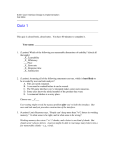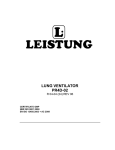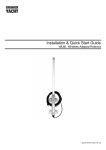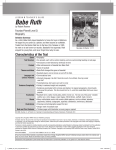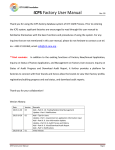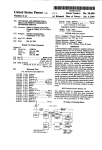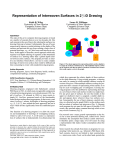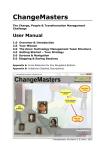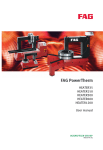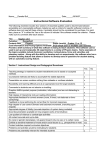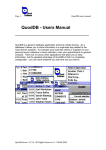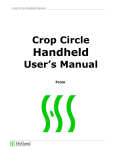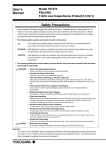Download Human Interface Design - Computer Science Unplugged
Transcript
Activity 19 The chocolate factory—Human interface design Age group Middle elementary and up. Abilities assumed No specific abilities required. Time An hour or more. Size of group From small groups to the whole classroom. Focus Design. Reasoning. Awareness of everyday objects. Summary The aim of this activity is to raise awareness of human interface design issues. Because we live in a world where poor design is rife, we have become accustomed (resigned?) to putting up with problems caused by the artifacts we interact with, blaming ourselves (“human error,” “inadequate training,” “it’s too complicated for me”) instead of attributing the problems to flawed design. The issue is greatly heightened by computers because they have no obvious purpose—indeed, they are completely general purpose—and their appearance gives no clues about what they are for nor how to operate them. From “Computer Science Unplugged” c Bell, Witten, and Fellows, 1998 Page 199 ACTIVITY 19. THE CHOCOLATE FACTORY—HUMAN INTERFACE DESIGN Technical terms Interface design; affordances; mapping; transfer effects; population stereotypes; icons; user interface evaluation Materials Each group of children will need: a copy of the blackline master on pages 209 and 210, and a copy of the images on page 211, either on overhead projector transparency or on cards that can be displayed to the class, and one or more of the six cards contained in the blackline master on page 212. Cut the sheet into individual cards and divide them between the groups. What to do The great chocolate factory is run by a race of elf-like beings called Oompa-Loompas.1 These Oompa-Loompas have terrible memories and no written language. Because of this, they have difficulty remembering what to do in order to run the chocolate factory, and things often go wrong. Because of this, a new factory is being designed that is supposed to be very easy for them to operate. 1. Divide the children into small groups and explain the story. 2. The first problem the Oompa-Loompas face is getting through the doors carrying steaming buckets of liquid chocolate. They cannot remember whether to push or pull the doors to open them, or slide them to one side. Consequently they end up banging into each other and spilling sticky chocolate all over the place. The children should fill out the “doors” worksheet on page 209. More than one box is appropriate in each case. For some of the doors (including the first one) it is not obvious how to open them, in which case the children should record what they would try first. Once they have filled out their own sheets, have the whole group discuss the relative merits of each type of door, particularly with regard to how easy it is to tell how it works, and how suitable it would be to use if you are carrying a bucket of hot chocolate. Then they should decide what kind of doors and handles to use in the factory. Follow this activity with a class discussion. Table 19.1 comments briefly on each door in the worksheet. Real doors present clues in their frames and hinges as to how they open, and there are conventions about whether doors open inwards or outwards. Identify the kinds of door handles used in your school and discuss their appropriateness (they may be 1 With apologies to Roald Dahl. You’ll know about the Oompa-Loompas if you’ve read his wonderful tale Charlie and the Chocolate Factory. If not, never mind: the plot is not relevant to this activity. Page 200 ACTIVITY 19. THE CHOCOLATE FACTORY—HUMAN INTERFACE DESIGN Plain door Can’t see how to open this one at all, except that since it has no handle, it must require pushing rather than pulling. Labeled door The label is like a tiny user manual. But should a door need a user manual? And the Oompa Loompas can’t read. Hinge door At least you can see which is the side that opens. Bar door It’s clear that you are supposed to push the bar, but which side? Handle door Handles like this are usually for pulling—or sliding. Knob door The knob shows what to grasp, but not whether to push or pull; it probably doesn’t slide. Panel door It’s clear that you push this. What else could you do? Glass door The small vertical bar on this side signals “pull”; the longer horizontal one on the other signals “push”. Sliding door This one’s only for sliding. Table 19.1: About the doors in the worksheet Page 201 ACTIVITY 19. THE CHOCOLATE FACTORY—HUMAN INTERFACE DESIGN quite inappropriate!) Do doors normally open inwards or outwards into corridors?—and why? (Answer: They open into rooms so that when you come out you won’t bash the door into people walking along the corridor, although in some situations they open outwards to make evacuation easier in an emergency.) The key concept here is what are called the affordances of an object, which are its visible features—both fundamental and perceived—whose appearance indicates how the object should be used. Affordances are the kinds of operation that the object permits, or “affords.” For example, it is (mostly) clear from their appearance that chairs are for sitting, tables are for placing things on, knobs are for turning, slots are for inserting things into, buttons are for pushing. And computers are for ... what? They have no affordances that indicate their functionality, apart from very low-level ones such as input (e.g. keyboard) and output (e.g. screen) capabilities. Doors are very simple objects. Complex things may need explaining, but simple things should not. When simple objects need pictures, labels, or instructions, then design has failed. 3. The pots containing different kinds of chocolate have to cook at different temperatures. In the old chocolate factory the stoves were as shown in the blackline master on page 210. The left-hand knob controlled the rear left heating element, the next knob controlled the front left element, the next one controlled the front right, and the right-hand knob controlled the rear right element. The Oompa-Loompas were always making mistakes, cooking the chocolate at the wrong temperature, and burning their sleeves when reaching across the elements to adjust the controls. The children should recall how the controls are laid out on their cookers at home and come up with a better arrangement for the new factory. Follow this activity with a class discussion. Figure 19.1 shows some common arrangements. All but the one at the lower left have the controls at the front, to avoid having to reach across the elements. In the design at the top left, there are so many possible mappings from controls to burners (24 possibilities, in fact) that eight words of labeling are needed. The “paired” arrangement in the top center is better, with only four possible mappings (two for the left cluster and two for the right); it requires just four labeling words. The design at the top right specifies the control–burner relationship diagrammatically rather than linguistically (which is good for the Oompa-Loompas!). The lower three designs need no labels. The left-hand one has a control by each burner, which is awkward and dangerous. The other two involve relocating the burners slightly, but for different reasons: in the center design they are moved to leave room for the controls, while in the right-hand one they are rearranged to make the correspondence clear. The key concept here is the mapping of controls to their results in the real world. Natural mapping, which takes advantage of physical analogies and cultural standards, leads to immediate understanding. The spatial correspondences at the bottom of Figure 19.1 are good examples—they are easily learned and always remembered. Arbitrary mappings, as in the top arrangements, need to be labeled, or explained and memorized. Page 202 ACTIVITY 19. THE CHOCOLATE FACTORY—HUMAN INTERFACE DESIGN Figure 19.1: Some possible cooker layouts Page 203 ACTIVITY 19. THE CHOCOLATE FACTORY—HUMAN INTERFACE DESIGN 4. The factory is full of conveyer belts carrying pots of half-made chocolate in various stages of completion. These conveyer belts are controlled manually by Oompa-Loompas, on instructions from a central control room. The people in the control room need to be able to tell the Oompa-Loompa to stop the conveyer belt, or slow it down, or start it up again. In the old factory this was done with a voice system: the control room person’s voice came out of a loudspeaker by the conveyer belt controls. But the factory was noisy and it was hard to hear. The groups should design a scheme that uses visual signals. One possibility is to put in lights to signal Stop!, Slow down and Start up. These should follow the normal traffic-light convention by using red for Stop!, yellow for Slow down and green for Start up. They should be arranged just like traffic lights, with red at the top and green at the bottom. But now reveal to the class that in Oompa-Loompa land, traffic lights work differently from the way they do for us: yellow means stop, red means go, and lights go green to warn people that they will soon have a stop light. How does this affect things? (Answer: the factory should follow the Oompa-Loompa’s traffic-light convention—we should not try to impose our own.) The key concepts here are those of transfer effects—people transfer their learning and expectations of previous objects into new but similar situations—and population stereotypes— different populations learn certain behaviours and expect things to work in a certain way. Although the traffic light scenario may seem far-fetched (though nothing is all that farfetched in Oompa-Loompa land), there are many examples in our own world: in America light switches are on when they are up and off when they are down, whereas in Britain the reverse is true; calculator keypads and touchtone phones are laid out in different ways; and number formats (decimal point or comma) and date formats (day/month/year or month/day/year) vary around the world. 5. When one shift of Oompa-Loompas finishes work in the chocolate factory, they must clean up and put away pots and pans and jugs and spoons and stirrers ready for the next shift. There is a cupboard with shelves for them to put articles on, but the next shift always has trouble finding where things have been put away. Oompa-Loompas are very bad at remembering things and have trouble with rules like “always put the pots on the middle shelf,” “put the jugs to the left.” The groups of children should try to come up with a better solution. Figure 19.2 shows a good arrangement (which is sometimes used—but for rather different reasons—on yachts and other places where it is necessary to stop things sliding around). The key concept here is to use visible constraints to make it obvious where everything is supposed to go. It is clear from the size and shape of each hole which utensil it is intended for: the designer has made the constraints visible and used the physical properties of the objects to avoid the need to rely on arbitrary conventions. 6. In the main control room of the chocolate factory there are a lot of buttons and levers and switches that operate the individual machines. These need to be labeled, but because the Page 204 ACTIVITY 19. THE CHOCOLATE FACTORY—HUMAN INTERFACE DESIGN Figure 19.2: Cupboard design that utilizes visible constraints Oompa-Loompas can’t read, the labels have to be pictorial—iconic—rather than linguistic. To give the children a feeling for icons, page 211 shows some examples. The children should identify what the icons might mean (for example, the letter going into a mailbox might represent sending a message). There are no “correct” answers to this exercise; the idea is simply to identify possible meanings. 7. Now let’s design icons for the chocolate factory. The cards on page 212 specify clusters of related functions, and each group of children receives one or more cards without the other groups knowing what they are. A control panel is to be designed for the function clusters that contains individual icons for each of the five or six operations. The groups then show their work to the other children, without saying what the individual operations are, to see if they can guess what the icons mean. Encourage the use of imagination, color, and simple, clear icons. Page 205 ACTIVITY 19. THE CHOCOLATE FACTORY—HUMAN INTERFACE DESIGN Figure 19.3: Instructions for an early VCR (from Human-Computer Interaction, by Preece et al., reproduced by permission of The Open University) Variations and extensions Can the children set the time on their electronic wristwatch? The mappings involved in the cooker layouts were simple because there were four controls for four burners. More difficulty occurs whenever the number of actions exceeds the number of controls. But the controls on wristwatches are often exceedingly complex. (“You would need an engineering degree from MIT to work this,” someone looking at his new wristwatch once told Don Norman, a leading user interface psychologist. Don has an engineering degree from MIT, and, given a few hours, he can figure out the watch. But why should it take hours?) VCRs pose an even more significant problem to most users, particularly adults (who are, after all, the principal customers). Try leading a class discussion on how the children’s VCRs are controlled. But beware: although it is likely that they are very badly designed from a human interface point of view, the children may have become very adept at using them and may find it Page 206 ACTIVITY 19. THE CHOCOLATE FACTORY—HUMAN INTERFACE DESIGN hard to see the problems (they say that if you see a VCR whose clock is not flashing 12:00, it’s a sure indication that the household contains teenagers.) Figure 19.3 shows a set of instructions and schematic diagram for an early VCR; from it the class could attempt to map a detailed list of instructions, in sequence, for recording a TV programme. Re-design the controls as a class exercise—the children could hardly do worse than this! What’s it all about? Human–computer interaction is about designing, evaluating, and implementing computer systems that allow people to carry out their activities productively and safely. In the old days, computers were for specialists and the users could be expected to be highly educated and specially trained in their use. But now computers are everyday tools that we all must use, and far greater attention must be paid to the human interface. Many disasters, some involving loss of life, have occurred because of inadequate interfaces: airplane crashes and even shoot-downs of civilian airplanes, freeway pile-ups because of errors in switching remotely-operated highway signs, nuclear power station disasters. On a smaller scale, most people experience frustration—often extreme frustration (a police officer once fired bullets into his computer screen)—with computers and other high-tech devices every day in the workplace. And it is not just computers: what about those shrink-wrapped packages that you could only open if you had sharp claws or a hooked beak, doors that hurt your wrist as you try to push your way through, milk cartons that always splash you when you open them, elevators where you can’t see how you’re supposed to push the button, home entertainment systems whose advertisements claim to do everything, but make it almost impossible to do anything? We are becoming used to “human error” and to thinking of ourselves as somehow inadequate; people often blame themselves when things go wrong. But many so-called human errors are actually errors in design. People have information-processing limitations and designers need Page 207 ACTIVITY 19. THE CHOCOLATE FACTORY—HUMAN INTERFACE DESIGN “The only reason we allow him inside is because he’s the only one that can work the VCR.” to account for these; bad design cannot be rectified by producing a detailed and complicated user manual and expecting people to study it intensively and remember it forever. Also, humans are fallible and design needs to take this into consideration. Interface evaluation is an essential part of the design process. The present activity has involved some evaluation when the children tested their icon designs on others. A more thorough evaluation would test the design on real Oompa-Loompas (who may perceive icons differently) in a carefully-controlled psychology-style experiment. Although the problems caused by technology—particularly VCRs!—form the butt of many jokes, human interface design is by no means a laughing matter. Inadequate interfaces cause problems ranging from individual job dissatisfaction to stock-market disasters, from loss of self-esteem to loss of life. Further reading Don Norman’s book The design of everyday things is a delightful—and liberating—account of the myriad design problems in everyday products. Jenny Preece’s encyclopedic Human– computer interaction is a very comprehensive account of this multidisciplinary field. We have drawn extensively on both of these sources when preparing this activity. Page 208 Instructions: Fill out the worksheet to show how you think each type of door opens. From “Computer Science Unplugged” c Bell, Witten, and Fellows, 1998 Page 209 Instructions: Redesign the stove so that the controls are easy to use. Front or back panels can be added to the design if desired. From “Computer Science Unplugged” c Bell, Witten, and Fellows, 1998 Page 210 Instructions: What do you think each of the icons (symbols) means? From “Computer Science Unplugged” c Bell, Witten, and Fellows, 1998 Page 211 Instructions: Cut out the cards and give one to each group. Have each group design icons (symbols) to put on a control panel to represent each instruction. From “Computer Science Unplugged” c Bell, Witten, and Fellows, 1998 Page 212















